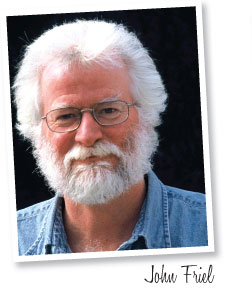3/1/2019
Beaks & Bucks
John Friel

March in the Mid-Atlantic is a frustrating month. For every advance spring makes, winter throws a nasty counterpunch. Some of our heaviest snowstorms have come in March, often after a promising thaw.
But then, this is a wonderful time to be, or to become, a birder—or to sell to birders. Winter, when cash flow otherwise slows to a trickle, is when sales of feed and feeders peak. Gardeners hang up their gloves in fall, but birders know no season. Feeders get action year-round and occasionally something interesting passes through.
One February morning, I was excited to spot two canvasbacks on the river behind my house—a first. These large, handsome ducks are uncommon, though not unknown, here. Such sightings always get a birder’s knickers in a twist. Perhaps that’s why I found myself making the registers ring at two garden centers.
Gardening and birding seem like natural partners, but they can clash. The pruning shears crowd and those who keep binoculars handy have much in common—and also some irreconcilable differences. Gardeners love to stroll, admire and exclaim, chatty as mynahs. Birders learn to freeze or creep, silent and stealthy as stalking herons. Each species may exasperate the other.
But birders can also be gardeners and vice-versa. From focusing on pollinators, many have moved onto planting food and habitat for birds. Perennials, annuals and shrubs all work. Seed-loving goldfinches are reason enough to put off deadheading your echinacea.
Kerry Lapp of Ken’s Gardens in touristy Intercourse, Pennsylvania, says that increasingly, customers ask for recommendations on what to plant for birds. Ironically, he says, some also ask how to keep birds from eating their winterberries. I can’t imagine an attractive way—or a reason—to do that.
When it comes to warm-weather birding, Kendra Pepe, Kerry’s sister, said hummingbirds are “an area with a lot of interest.” Customers come looking for just the right feeder and/or for flowers that give hummers something more natural than sugar water.
Many plants fit that spec, especially those with tubular flowers, like salvia, monarda, agastache and nepeta. I’ve seen hummers make repeated visits to baskets of fuchsia.
Ornamental grasses have value, mainly as habitat. Big bluestem (andropogon) shelters songbirds like sparrows and meadowlarks. Some insects overwinter in grasses, and if you want birds other than seed-eaters, you need bugs.
I’m a fan of both native and non-native plants, but not of alien avifauna. Obnoxious European starlings steal the suet I put out for woodpeckers. Aggressive English sparrows bully bluebirds from their homes. They’re the kudzu of the animal kingdom.
But their crimes fade beside those of that birder’s bane, the wily gray squirrel. Foods they allegedly won’t eat, like hot pepper-laced suet, are money-makers, as are feeders they allegedly can’t feed from.
At Middle Creek Lawn and Patio in Leola, Jolynn Oberholtzer told me “people who are serious about birds will spend the extra money” for squirrel-resistant products. Middle Creek’s main business is landscaping and maintenance. In 2016, their retail center replaced a traditional hardware store. I lament the departure, but I applaud the newcomer. Garden center openings are as rare, and as welcome, as canvasbacks.
So that’s early March in PA. Spring will prevail. The sap is already rising: maple syrup makers, hardy souls, have been out in the sugarbush bleeding trees for weeks. Migratory birds are straggling in. But don’t count on birds alone, especially that traditional harbinger, the robin.
When you see snakes sunning themselves, you can safely say spring’s arrived. As a friend who grew up on a farm observed, “Robins are optimists. Snakes know.” GP
John Friel is marketing manager for Emerald Coast Growers and a freelance writer.